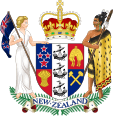Minister of Finance (New Zealand) facts for kids
Quick facts for kids Minister of Finance |
|
|---|---|

|
|

|
|
| The Treasury | |
| Style | The Honourable |
| Member of |
|
| Reports to | Prime Minister |
| Seat | Wellington |
| Nominator | Prime Minister |
| Appointer | Governor-General of New Zealand
on the advice of the prime minister
|
| Term length | At His Majesty's pleasure |
| Formation | 3 May 1841 |
| First holder | George Cooper as Colonial Treasurer |
| Salary | $288,900 |
| Website | www.beehive.govt.nz |
The Minister of Finance (Māori: Minita mo nga Moni) is a very important job in the New Zealand Government. This person is in charge of New Zealand's money. They lead a group called the Treasury.
The Minister of Finance has a big role. They create the country's yearly spending plan. This plan is called the budget. It shows how the government plans to spend money. This job is often seen as the second most important after the Prime Minister.
The current Minister of Finance is Nicola Willis. She started this role on November 27, 2023. There are also three other ministers who help her. They are called associate ministers.
Contents
What the Minister of Finance Does
Key Responsibilities
One main job of the Minister of Finance is to create the yearly budget. This budget is a detailed plan. It shows how the government will spend money on things like schools, hospitals, and roads.
The Minister of Finance has a special power. They can say "no" to new laws. This happens if a new law would cost too much money. It helps keep the government's budget plans on track.
Leading the Treasury
The Minister of Finance also oversees the Treasury. The Treasury is a government department. It gives advice to the government. This advice is about money and how the country's economy is doing.
Because of this, the Minister of Finance controls a lot of government spending. This makes the position very powerful. They decide where much of the country's money goes.
Influence and Power
Sometimes, the Minister of Finance can be even more powerful than the Prime Minister. This happens when certain conditions are right. For example, Gordon Coates was a Finance Minister in the 1930s. He had a lot of influence.
Some experts believe that in the past, the Treasury had too much control. They think it tried to manage the whole government. To balance this, a new department was created. It helps the Prime Minister get advice from other sources.
History of the Finance Minister Role
Early Days: Colonial Treasurer
The job of managing New Zealand's money started a long time ago. It began in 1841. Back then, the person in this role was called the "Colonial Treasurer." This name was used because New Zealand was a British colony.
This job is one of the oldest in the New Zealand government. Only the Attorney-General and Minister of Internal Affairs roles are as old.
From Colony to Dominion
In 1907, New Zealand became a "Dominion." This meant it was more independent from Britain. After this, the name of the job changed. "Colonial Treasurer" became "Minister of Finance." This change happened when Joseph Ward was in charge.
Prime Ministers and Deputy Prime Ministers in the Role
In the past, some Prime Ministers also held the job of Minister of Finance. This meant they were in charge of both roles at once. However, this is not common anymore. Robert Muldoon was the last Prime Minister to do this. His decision caused some debate.
It is more common for the Deputy Prime Minister to also be the Minister of Finance. Several people have held both these important jobs. These include Bob Tizard, Michael Cullen, Bill English, and Grant Robertson.
Seniority in Government
Ministers of Finance usually rank very high in government. They are often second or third in importance. This shows how crucial their role is. However, sometimes their rank can be lower. This might happen if they are new to Parliament.
Junior Ministers in Finance
Supporting the Main Minister
The idea of having junior ministers to help the Minister of Finance started in 1967. These helpers are called "Associate Ministers of Finance." They support the main minister. They help with the many tasks involved in managing the country's money.
Having associate ministers became a regular practice. This was especially true when the Prime Minister also held the Finance role. Sometimes, these associate ministers were appointed to help guide big changes.
Sharing Responsibilities
In governments made up of different political parties, the finance roles can be shared. For example, after the 1996 elections, the job was split. There was a Minister of Finance and a "Treasurer." The Treasurer was a more senior role. This was done for Winston Peters, who was the leader of a different party.
Later, these two roles were combined back into one Minister of Finance job. Today, associate finance roles are still common. They are often part of agreements between different parties in a coalition government.
Images for kids
-
Joseph Ward, who was Prime Minister when the title changed to Minister of Finance in 1907.
-
Robert Muldoon, the last Prime Minister to also serve as Minister of Finance.
-
Bill English, who served as both Deputy Prime Minister and Minister of Finance.
-
Grant Robertson, a recent Minister of Finance.









